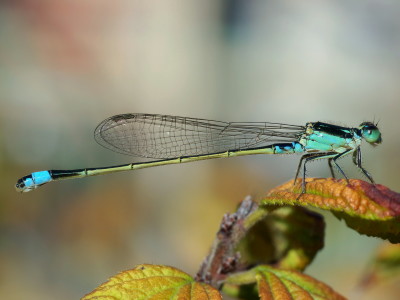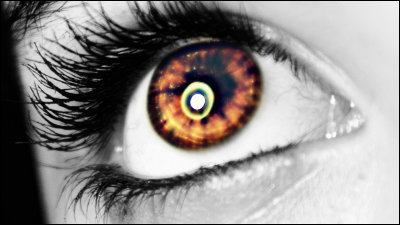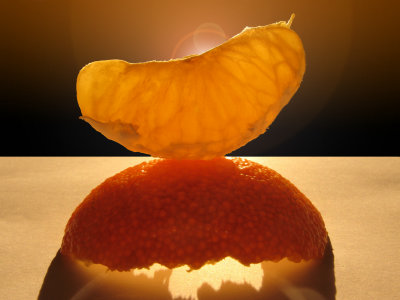In the eyes of the birds the mystery lurking in nature is hidden

"Bird's eyes" can capture more information than human eyes and can see ultraviolet rays which can not be seen by humans. A scientist who was interested in such a bird's eyes examined the retina of the bird, and found a mysterious arrangement pattern with conflicting characteristics of "regularity" and "irregularity".
Hyperuniformity Found In Birds, Math And Physics | Quanta Magazine
https://www.quantamagazine.org/20160712-hyperuniformity-found-in-birds-math-and-physics/
Mr. Joe Corvo working at the Institute of Biology at the University of Washington started research on the eyes of the birds around 2009. Mr. Corvo who was observing the chicken's retina with a microscope, since it is distributed in the central part of the retina and expresses visual substances having different wavelength characteristics, it is a cell which becomes the basis of color vision "Pyramidal cellI found that they are lined like polka dots with five different colors and sizes.
In the case of humans, this pyramidal cell is irregularly aligned in the central part of the retina. On the other hand, in the case of fish, pyramidal cells on the retina are regularly arranged in rows. However, chicken pyramidal cells are lined up randomlyUniform distributionIt turned out to be. The disposition of pyramidal cells does not conform to discernable rules, but they are located too close to each other and not too distant, which is the characteristic seen in each of the five cone cells. In other words, the disposition pattern of chicken pyramidal cells is extremely mysterious that it has two contradictory characteristics, "regularity" and "irregularity".
The figure below shows the distribution of such pyramidal cells of chickens, on the left, the distribution of five types of pyramidal cells in five colors green, blue, violet, black, and red, and on the right side, five Individual distribution of each is shown. Although the five types of pyramidal cells differ in number and size, you can see that they are not too close together and are arranged irregularly at a distance that is not too far away.
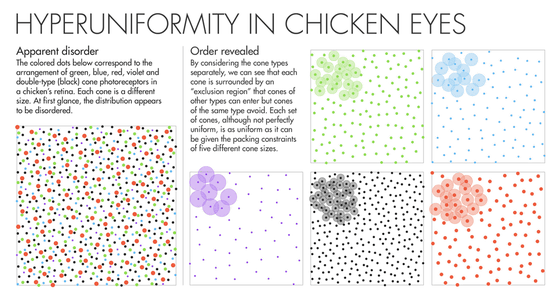
About this, Mr. Corvo said "Simply looking at these patterns makes me feel very beautiful, we are captivating this beauty and want to know more about the arrangement pattern of this pyramidal cell from pure curiosity I am thinking. "
Birds' sight is very good, for example, Taka can distinguish the rat on the ground from 1 mile above the sky (about 1.6 km). Many of these characteristics of birds' eyes are thought to be living creatures like lizards that are ancestors of birds 300 million years ago, that is to say they are inherited from dinosaurs. Some dinosaurs considered to be ancestors of birds are nocturnal, and the number of colors that can gradually be recognized decreases instead of turning around at night.
Approximately 30 million years ago, the number of pyramidal cells of the same ancestor of the same primate as human beings was very small, only 2 (red and green). This was also a degeneration due to the evolution of the nocturnal nature, but after that, the human acquires the blue pyramidal cells and gains the same visual ability as it is now. The human pyramidal cells are particularly close to red and green ones, and they are said to be very irregularly arranged.
In contrast, pyramidal cells of avians are slowly optimized for the modern environment with long years and years. The number of pyramidal cells on the retina of birds is very large, and it is also characterized by being arranged at regular intervals. But why are bird's pyramidal cells not regularly lined up like that of fish? The strange and difficult to categorize its placement pattern is "probably optimized for unknown constraints," Mr. Corvo thinks.
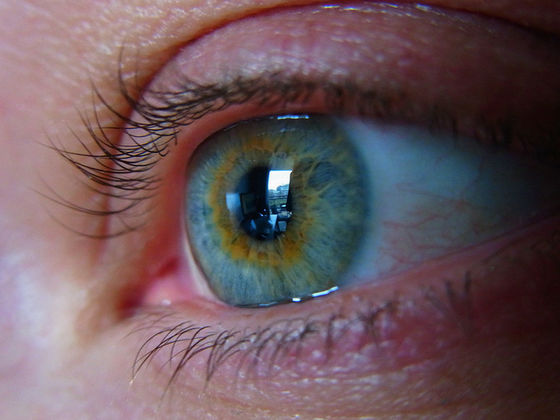
ByGordon Wrigley
In order to investigate this unknown pattern, Mr. Corvo will contact Salvatore Torucard, a professor of theoretical chemistry at Princeton University in 2012. When Mr. Trukart studied the arrangement pattern of birds pyramidal cells by computer using several algorithms, surprisingly it seems that "the same pattern as seen with inorganic matter and physical laws was seen" is. Mr. Trukart has been studying this arrangement pattern since the early 2000s, and this is called "hyperuniformity" or "superhomogeneity".
This "super uniformity" is not only the eyes of birds but "Quasicrystal"Mathematical matrices due to complete random numbers, the structure of the universe, the whole quantum, emulsions and colloids, etc. Scientists are still investigating how this "super uniformity" is born. Mathematician at Microsoft Research New England Mr. Henry Kohn said, from a mathematical point of view, "The more you study the super uniformity, the more beautiful it is, the more it is conceptually convincing." I talk about the wonder of super uniformity.
Related Posts:
